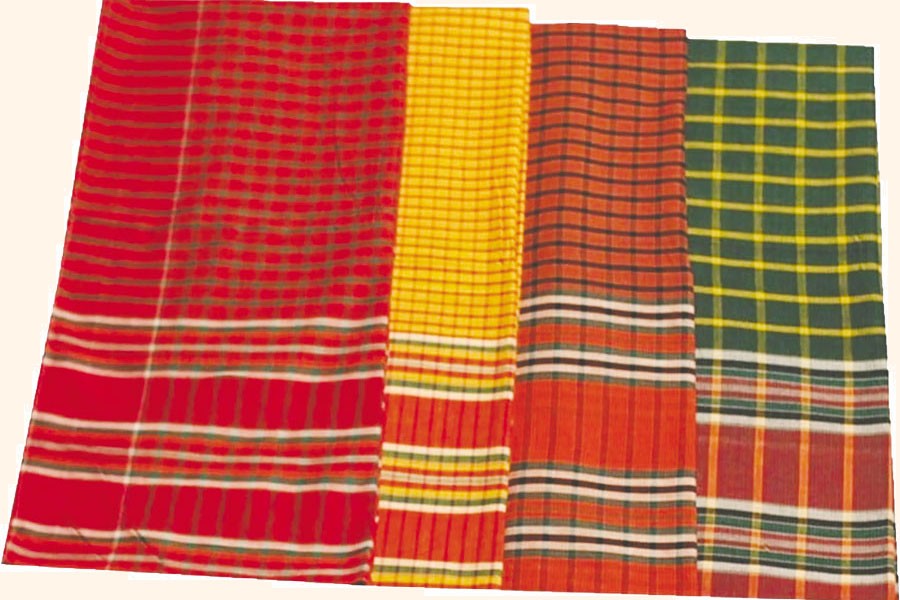
A CLOSE LOOK
In praise of ordinary but widely used gamchha
Nilratan Halder | Saturday, 28 September 2024

Iccha kare paraandare
Gamchha dia bandhi
Nothing could do more than the above song sung by Pankaj Mitra to immortalise gamchha. This towel-like body wiper is a special piece of cloth of unique designs, patterns and colours. Its multi-purpose usages make it different from towel. In the song, the lovelorn protagonist finds no better thing than gamachha to quell the tumultuous emotions in the heart. Gamchha's use here is at its metaphorical best.
However, its practical utility far surpasses any other piece of cloth. From the everyday use as a wiper of the body after bath it has its ritualistic indispensability for the Hindu's worship (puja) of gods and goddesses and for the last rite performed at the death of the aged or the young. Colourful check of a gamchha easily draws people's attention. When it is worn as a headband or as a headgear, it conveys different messages. As a headgear, it has its different usages. Under the scorching sun, gamchha protects the head when farmers work in the open field or harvest their crops. It can be used as a pad on the head when something heavy is carried on the temple. Then it can be used similarly when a number of people carry a log on their shoulders. But the same gamchha is tied as a headgear with two ends hanging elongated on one side of the head. This is symbolic of chivalry. The lathials (warriors who are expert in fighting with long sticks) make good use of gamchha in this manner to announce their bravery.
Even its daily routine use cannot be replaced by the furry towel the so-called bhaddorlok (gentry) class uses. Newly elevated, members of this class do so more for the sake of distinguishing themselves from the class they have emerged than for practical use. A towel cannot be used as a rinser and soaked everyday but a gamchha proves very handy for this purpose. At the time of rinsing body, it is the most suitable piece of cloth and once its use is over after the bath, it does not take long to dry. It can be used to thoroughly cleanse the body including the back and then wipe well. Villagers use large gamchhas because at times those can be worn temporarily before changing dress. Gamchha serves as a bathrobe then, but it can as well be used as a wrapper for the body when the air is a little cool. Apart from its use as a loin cloth, it can fasten lungi or dhuti tightly at the waist so that one feels additional spur to perform one's daily chores.
The other usages of gamchha can be quite striking. For example, Bibi Russel made gamchha as an iconic fashion on the international stage. Bangabir Kader Siddique made this common piece of cloth his party symbol. He has a gamchha hanging around his neck no matter what the function he is attending. But the Bauls and folk singers have used gamchha as their symbol to demonstrate their identity. Rahul Ananda is one such artiste who has made gamchha part of his colourful attire. Earlier this piece was used for begging by blind or handicapped beggars. Gamchha has, however, a thicker version which is thinner than the furry towel. Some people use those as an alternative.
So much for the usage of gamchha. Now it would be wise to give attention to the places where this cloth is produced and who are the weavers of those. The most famous area is, of course, Sirajganj. Villages under Sirajganj Sadar, Kamarkhand, Ullapara, Belkuchi and Shahjadpur produce gamchha with demand from all across the country. Then there are the highly artistic types of gamchha produced at Fultala in Khulna. Jhalakathi is yet another place that can challenge its rivals for producing the finest gamchha.
The artisan class has been weaving this material for generations. But of late they are not particularly well off. One of the reasons is the escalation of price of yarn and dyes. The margin of profit is dwindling over the years. One good thing is that gamchha is not produced in factories. It is still a specialty of handlooms. But if the artisans have to struggle for survival because their occupation is becoming uncompetitive, something has to be done about it. The duty on yarn and dye they use can be reduced in order to make the materials less costly. This would leave them a modest profit margin for continuing their occupation. Long live gamchha!